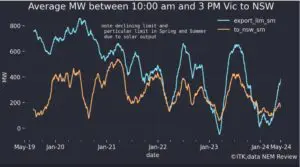The initial results of an Australian demand response trial has found that residential customers are not responding as well as bigger industrial energy users, and customer apathy means households are deliver demand reductions that are below expectations.
Results from the second year of demand response trials published by the Australian Renewable Energy Agency showed that while commercial and industrial customers consistently overdelivered on demand response measures, households were not.
Three electricity retailers are currently participating in the ARENA supported trial; AGL, EnergyAustralia and Powershop, with the retailers rewarding customers who successfully reduce their electricity demand during periods when the energy system is pushed to its limits.
The trial is a step towards the wider roll out of demand response measures, allowing households and businesses to manage their energy use in a way that balances customer needs with the real costs of serving energy, particularly in high demand periods, such as summer days when air conditioner use peaks.
During the second year of the trial, residential customers delivered an average of 84.3 per cent of the amount of demand response participating retailers have contracted to deliver. It is a result that is consistent with the 84 per cent delivery observed in the first year of the trial, and raises some questions about the best way to include residential energy users in demand response mechanisms.
But in comparison, commercial and industrial energy users continued to significantly over deliver in demand response requests, delivering 138.7 per cent of their contracted demand response capacity.
Under the trial, a total of 176MW of demand response was contracted across all of the trial participants, with average compliance across all customers reaching 132.9 per cent, or delivering an actual average demand reduction of 233.8MW.
While demand response providers generally ‘over-recruit’ customers to participate in demand response measures, to provide a buffer that allows providers to fulfil contracts even if some customers are unable to participate in a specific demand response event, the trial results suggests that compliance is generally higher than initially expected for commercial and industrial energy users.
However, trial participant, EnergyAustralia, said that it had encountered some difficulties in encouraging households to participate in the demand response program. One challenge was convincing households to switch to load-control devices, as customer interest in having a free load-controlling device was low.
But not all of the shortcomings in demand response from residential customers was due to lack of consumer interest.
AGL Energy, which sought to facilitate residential demand response by remotely controlling customer air conditioning systems found that the process of setting up such a system was unexpectedly complex.
According to the latest trial report, AGL said that not all air conditioner systems were compatible with demand response services, that technical standards made it difficult for customers to appropriately opt-out of demand response events, and that longer than expected events lead to customer complaints.
In its own response, Powershop said that while it was able to successful engage its most enthusiastic customers in demand response mechanisms, it also found that less engaged customers less likely to be persuaded to participate.
This created a dual issue, whereby customer participation in demand response measures was limited to only those engaged in managing their energy use, who also generally happen to be the households with the least amount of energy consumption that can be switched off.
All retailers reported that households with rooftop solar also presented a challenge, as these households were often more likely to participate in demand response measures due to being generally more contentious in their energy use, but delivered less benefits in terms of demand response as appliances being switched off were often already being supplied by their rooftop solar system.
The presence of a rooftop solar installation also made it more difficult for electricity retailers to assess the impact of a demand response measure, as it was sometimes difficult to disaggregate the output of a solar system with household energy consumption.
The trial is being undertaken with the support of ARENA funding, and will report final results after a third year of operation.










